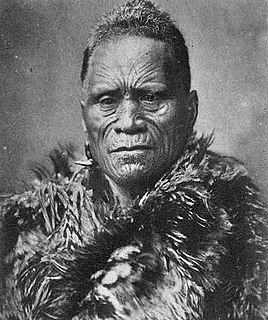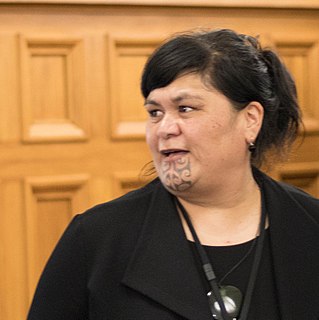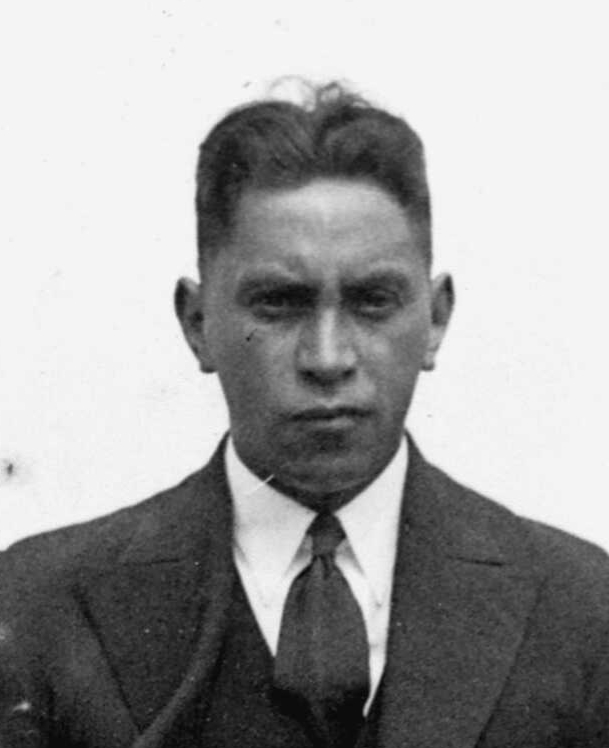
Tāwhiao was leader of the Waikato tribes, the second Māori King and a religious visionary. He was a member of the Ngāti Mahuta iwi (tribe) of Waikato.

Nanaia Cybelle Mahuta is a New Zealand politician who currently serves as the Minister for Māori Development and Minister for Local Government. She was previously a cabinet minister in the Fifth Labour Government of New Zealand, serving then as Minister of Customs, Minister of Local Government, Minister of Youth Development, Associate Minister for the Environment, and Associate Minister of Tourism. She has strong links to the Māori King Movement, being the daughter of Sir Robert Mahuta, who was the adopted son of King Korokī and the elder brother of Māori Queen Te Atairangikaahu. She has an MA (Hons) in social anthropology. In 2016, she acquired a Māori facial tattoo and became the first female MP to wear one in the New Zealand parliament.

Te Matua Ngahere is a giant kauri coniferous tree in the Waipoua Forest of Northland Region, New Zealand. The tree's Maori name means "Father of the Forest". Although not as massive or tall as its neighbour Tāne Mahuta, Te Matua Ngahere is stouter, with a girth just over 16 metres (52 ft). It is believed to be the second largest living kauri tree, and to have the biggest girth of any kauri in the country. According to The New Zealand Herald, it has the biggest girth of any tree in New Zealand.

Dame Te Atairangikaahu was the Māori queen for 40 years, the longest reign of any Māori monarch. Her full name and title was Te Arikinui Dame Te Atairangikaahu. Her title Te Arikinui and name Te Atairangikaahu were bestowed when she became monarch; previously she was known as Princess Piki Mahuta and, after marriage, Princess Piki Paki.

Pōtatau Te Wherowhero was a Māori warrior, leader of the Waikato iwi (tribes), the first Māori King and founder of the Te Wherowhero royal dynasty. He was first known just as Te Wherowhero and took the name Pōtatau after he became king in 1858. As disputes over land grew more severe Te Wherowhero found himself increasingly at odds with the Government and its policies.

Korokī Te Rata Mahuta Tāwhiao Pōtatau Te Wherowhero was the fifth Māori King. He was the elder son of the fourth Māori King, Te Rata Mahuta, and Te Uranga Matai of the Ngāti Korokī tribe. He was named Korokī after the ancestor of his mother's tribe.
Te Rata Mahuta was the fourth Māori King, reigning from 1912 to 1933.

Mount Taupiri is a hill at the southern end of the Taupiri Range in the Waikato. The highest peak in the range, it rises to 288 metres above sea level and overlooks Taupiri township immediately to its south. It is separated from the Hākarimata Range to the south by the Taupiri Gorge, through which the Waikato River flows from the Waikato Basin to the Lower Waikato. The Mangawara Stream joins the Waikato River at the base of the hill.
The Māori renaissance is the revival in fortunes of the Māori of New Zealand beginning in the latter half of the twentieth century. During this period, the perception of Māori went from being that of a "dying race" to being politically, culturally and artistically ascendant.

Wiremu Tamihana Tarapipipi Te Waharoa, generally known as Wiremu Tamihana, was a leader of the Ngāti Hauā Māori iwi in nineteenth century New Zealand, and is sometimes known as the kingmaker for his role in the Māori King Movement.

Wiremu Te Morehu Maipapa Te Wheoro (1826–1895), also known as Major Te Wheoro and later as Wiremu Te Morehu or William Morris, was a 19th-century Māori member of the House of Representatives.
Sir Robert Te Kotahi Mahuta was a prominent Māori politician. He was born Robert Jeremiah Ormsby and changed his name by deed poll.
Tāmati Ngāpora was a New Zealand Waikato leader, lay preacher, assessor and adviser to the Māori King.
Piupiu Te Wherowhero was a female leader within the Māori royal family in early 20th century New Zealand.
Ngāti Te Wehi or Ngāti Te Weehi is a Māori iwi (tribe) based in Kawhia on the west coast of New Zealand's North Island.

Whakaawi was a Māori woman of high birth in both the Ngāti Te Wehi tribe and Ngāti Mahuta tribe, who was the senior wife of the chief Pōtatau Te Wherowhero, who died in 1860. His other wives were Waiata, Raharaha and Ngawaero.

The Kotahitanga movement was an autonomous Māori Parliament convened annually in New Zealand from 1892 until 1902. Though not recognised by the New Zealand Government, the Māori Parliament was an influential body while it lasted. By 1902 its role was largely superseded by the Māori Councils established by James Carroll and Hone Heke Ngapua through the Māori Councils Act 1900. As a result, Kotahitanga members unanimously voted for its dissolution at the 10th Parliament at Waiōmatatini in 1902.















